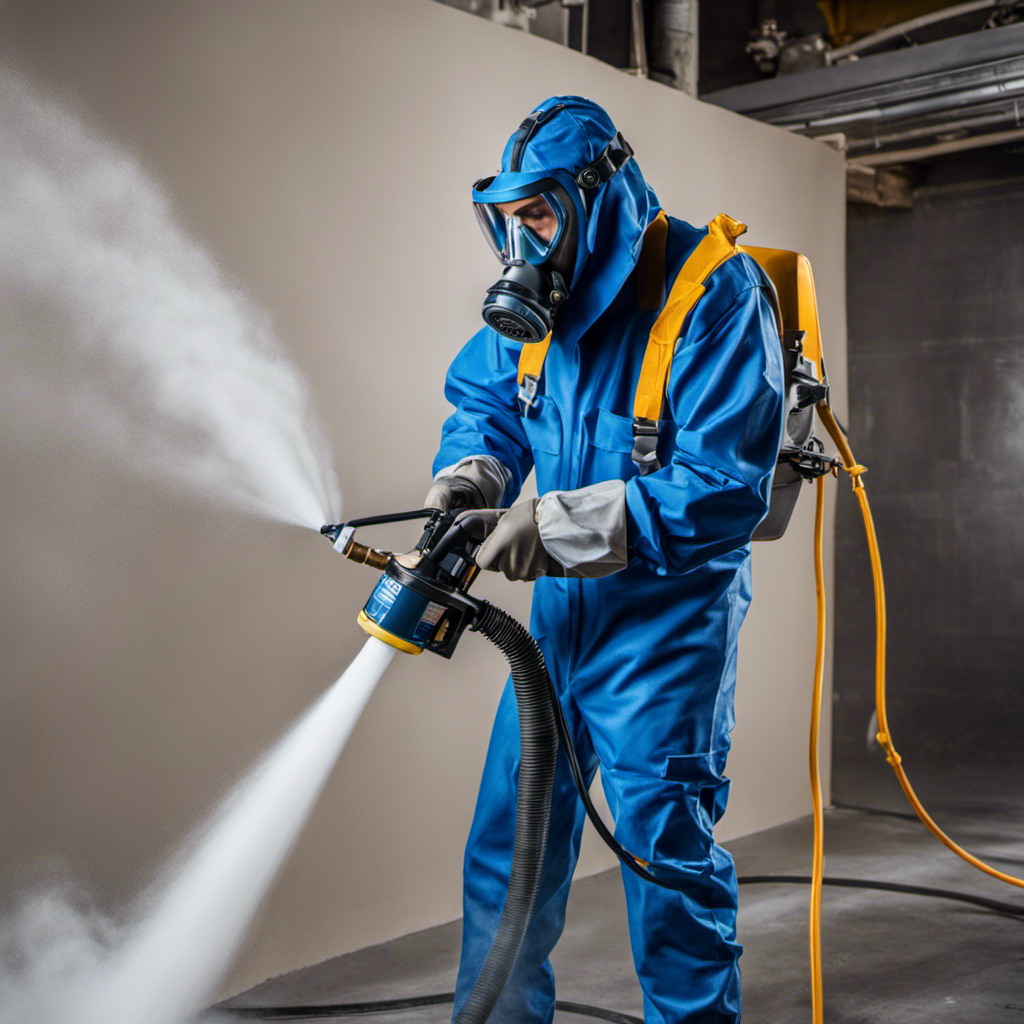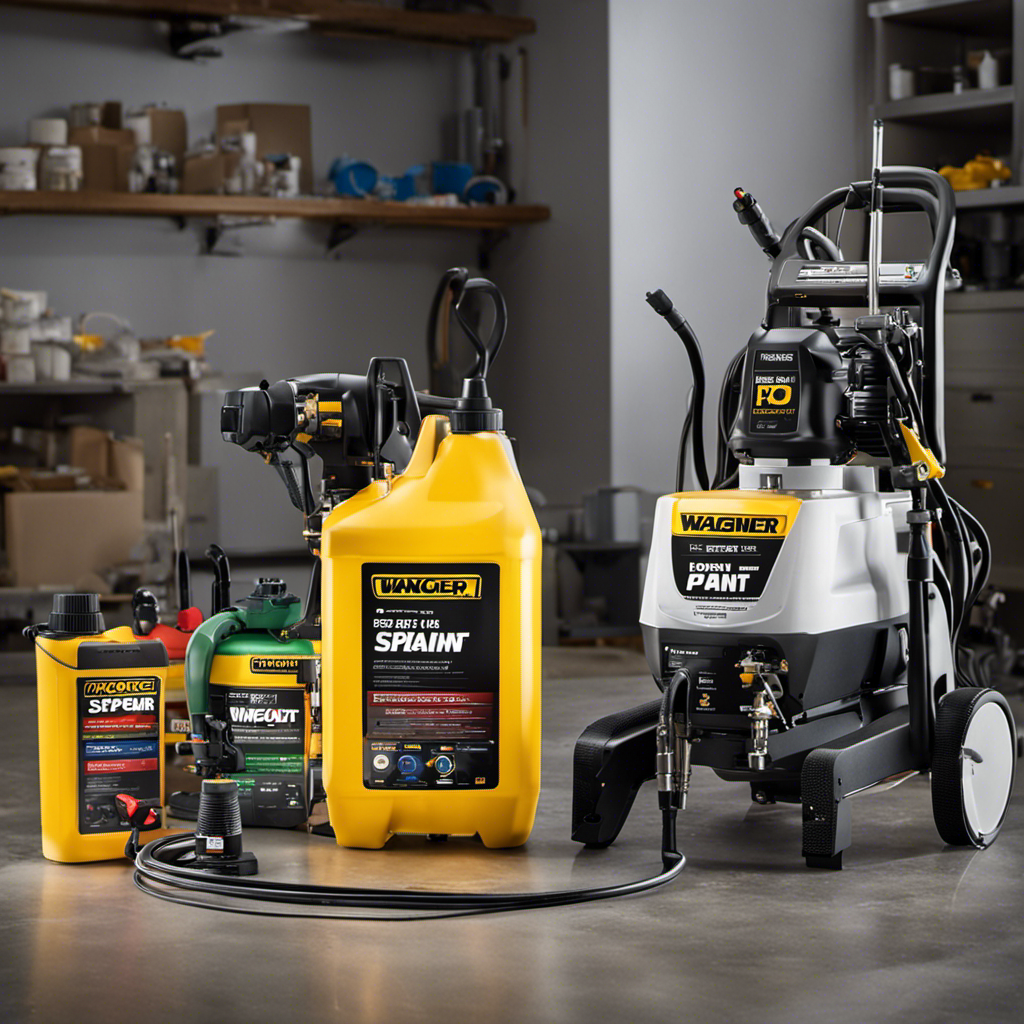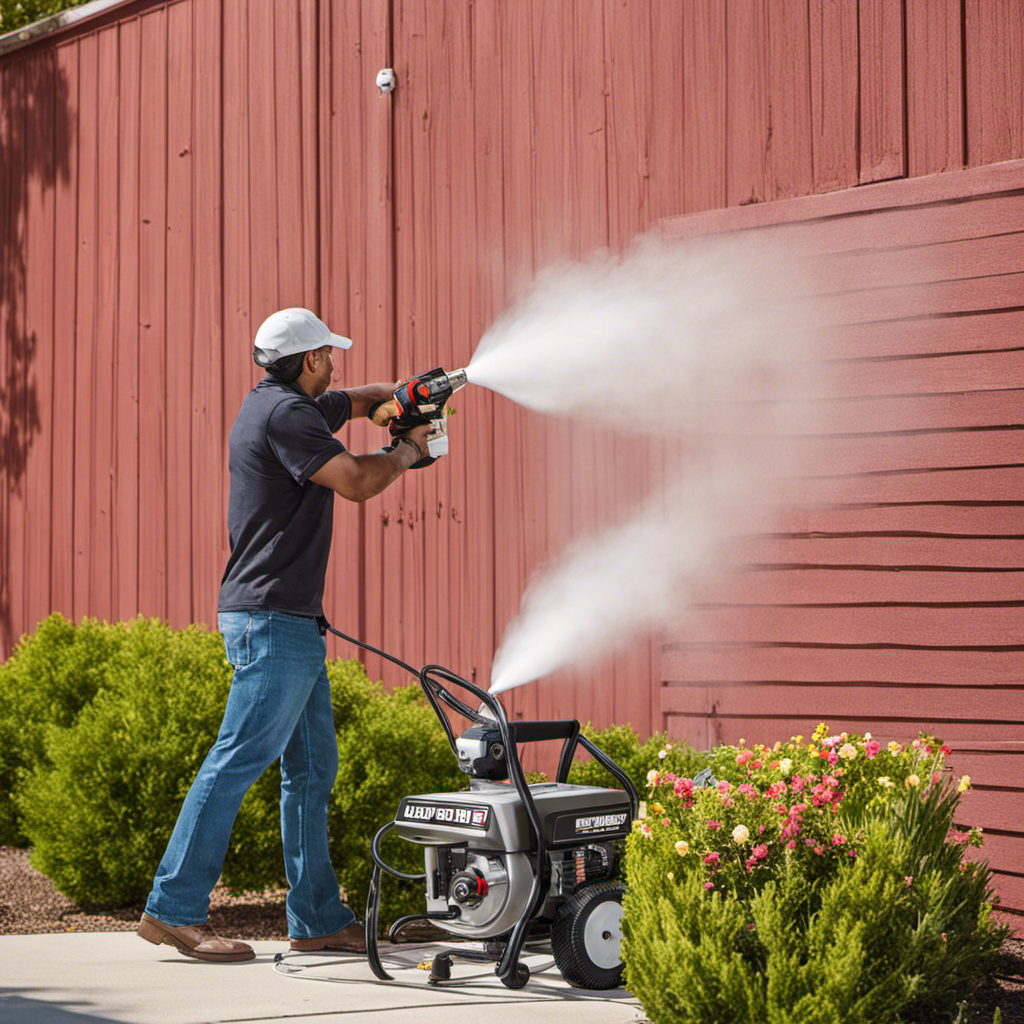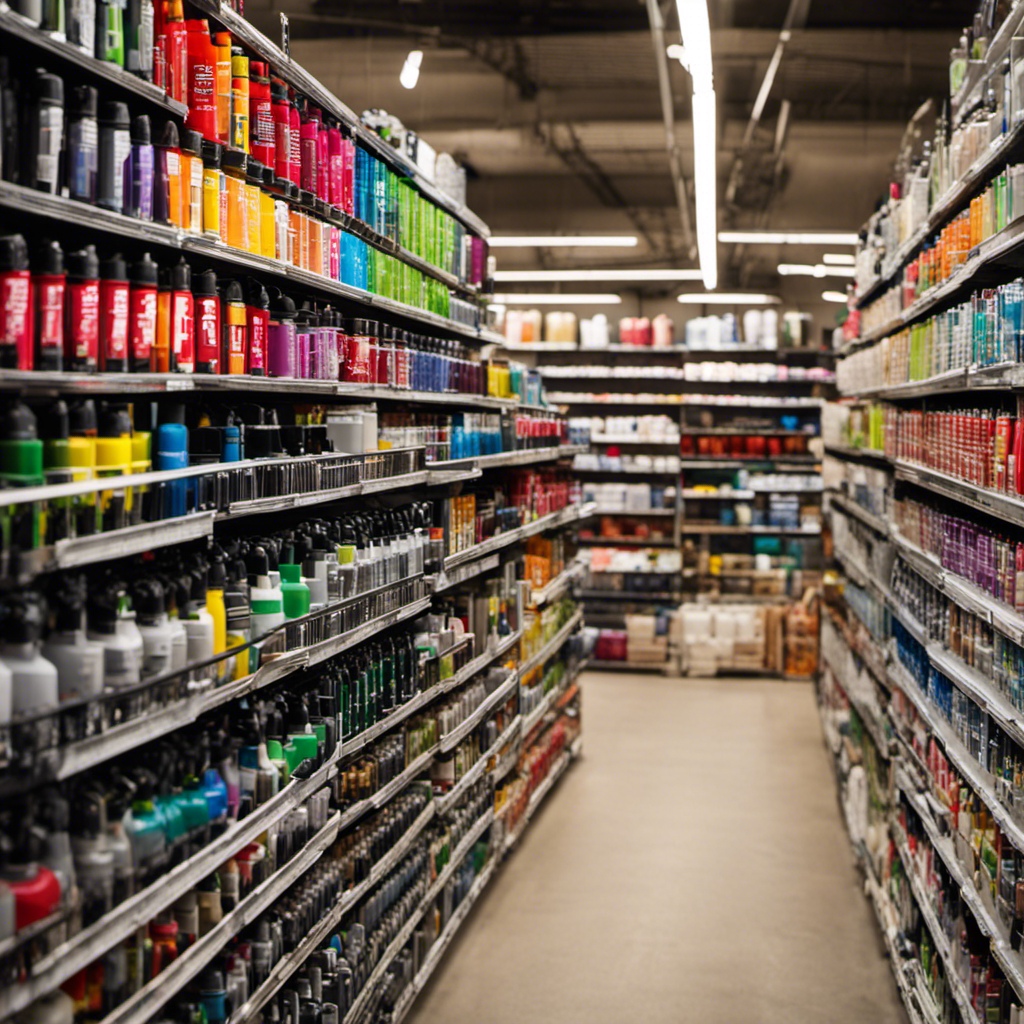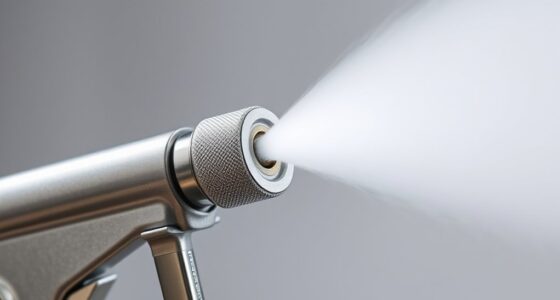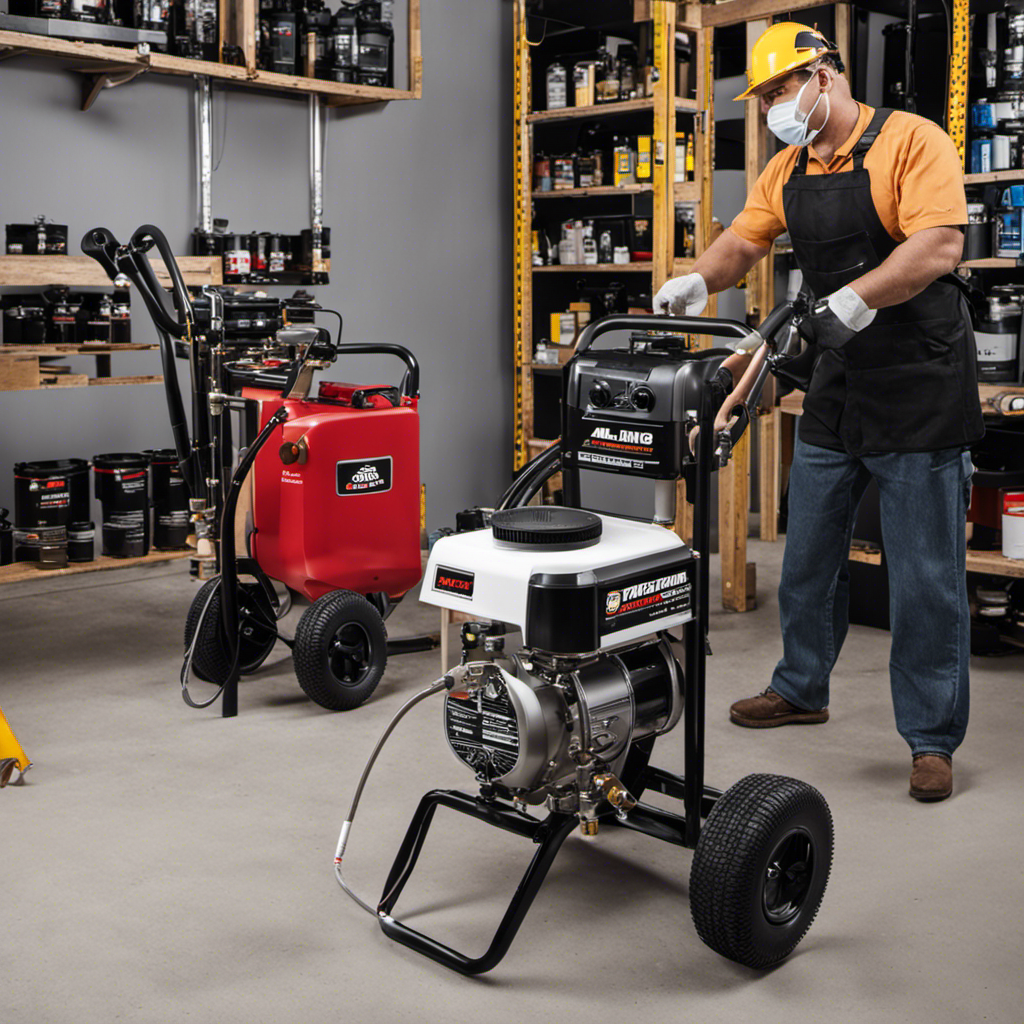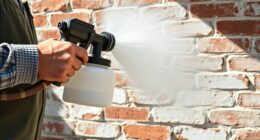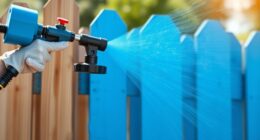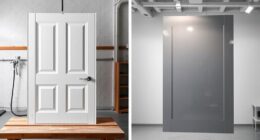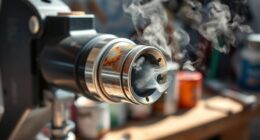Are you searching for a convenient method to achieve perfect paint jobs? Your search ends here – our article titled ‘Protective Gear and Tips for Airless Paint Sprayer Success’ is the solution for you.
Discover the essential protective gear, from goggles to respirator masks and gloves, that will keep you safe while wielding your airless paint sprayer.
Learn how to troubleshoot paint clogs, maintain your sprayer for optimal performance, and achieve an even spray pattern for professional results.
With these tips and tricks, you’ll be painting like a pro in no time.
Key Takeaways
- Wear protective goggles, a respirator mask, gloves, and proper clothing to protect yourself from paint particles and fumes.
- Create a good working environment by covering the floor, using painters tape, removing furniture, and ensuring proper ventilation.
- Troubleshoot paint clogs by checking viscosity, straining the paint, cleaning or replacing spray tips, using a paint filter, and maintaining proper pressure settings.
- Achieve an even spray pattern by calibrating the sprayer, adjusting pressure and fan width, holding the sprayer at the correct distance, and practicing overlapping passes.
Importance of Protective Gear for Airless Paint Sprayer Use
Wearing protective gear is crucial for ensuring safety and preventing contact with paint particles while using an airless paint sprayer. This includes goggles, a respirator mask, gloves, and clothing that covers the skin.
When choosing a respirator mask, it is important to select one specifically designed for protection against paint fumes and airborne particles. Look for masks labeled as N95 or N100, as they provide a higher level of filtration.
Wearing gloves is important to keep your hands clean and protect them from potential irritants in the paint.
Equally important is wearing clothing that covers your skin to prevent paint splatters and potential skin contact.
Choosing the Right Protective Goggles
To shield their eyes from paint particles, painters should opt for goggles that offer proper protection. When choosing the right goggles, it is important to consider the following factors:
- Fit: Goggles should fit snugly around the eyes to prevent any paint particles from entering.
- Lens material: Look for goggles with impact-resistant lenses to provide maximum protection.
- Anti-fog feature: Goggles with an anti-fog coating or ventilation holes can prevent fogging, ensuring clear vision.
- Adjustable straps: Goggles with adjustable straps provide a secure and comfortable fit.
- Compatibility with other protective gear: Ensure that the goggles can be worn with a respirator mask for complete face protection.
In addition to wearing goggles, painters should also use respirator masks to protect against fumes and airborne paint particles. Proper use of respirator masks is crucial to ensure safety and minimize exposure to harmful substances.
Respirator Masks for Fume and Particle Protection
Respirator masks should be properly fitted to the face to ensure maximum protection against fumes and airborne paint particles. There are different types of respirator masks available, each offering varying levels of protection. It is important to choose the right mask for the job and ensure a proper fit to prevent any gaps that may allow contaminants to enter.
To help you understand the different types of respirator masks and their proper fit, here is a table:
| Respirator Mask Type | Level of Protection | Proper Fit |
|---|---|---|
| N95 | Filters out 95% of particles | Should fit snugly on the face |
| P100 | Filters out 99.97% of particles | Should create a seal around the face |
| Half-mask | Covers the nose and mouth | Should be tight-fitting and cover the chin |
The Best Gloves for Spray Painting
The ideal gloves for spray painting are ones that provide both protection and dexterity. When it comes to choosing the best gloves for this task, there are a few key factors to consider.
First and foremost, the gloves should offer sufficient hand protection to shield against any potential hazards or chemicals present in the paint. Additionally, they should allow for a good range of motion and tactile sensitivity to ensure optimal dexterity while handling the sprayer.
Here are some factors to keep in mind when selecting gloves for spray painting:
- Look for gloves made from durable materials such as nitrile or neoprene.
- Consider gloves with textured surfaces for improved grip.
- Opt for gloves that are resistant to chemicals and solvents.
- Choose gloves that are comfortable and properly fitted to prevent hand fatigue.
- Consider gloves with extended cuffs for added wrist protection.
Clothing Choices for Paint Splatter Prevention
When choosing clothing for spray painting, it’s important to select garments that cover the skin to prevent paint splatters.
There are various clothing options available that can help in paint splatter prevention techniques. One option is to wear a long-sleeved shirt or a coverall that provides full coverage. This will protect your arms and torso from any accidental paint splatters.
Additionally, wearing pants instead of shorts or skirts can protect your legs from getting stained. It is also advisable to wear a hat or a cap to protect your hair from paint drips.
Lastly, choosing dark-colored clothing can help conceal any paint stains that may occur during the painting process.
Safety Considerations: Closed-Toe Shoes
Closed-toe shoes are essential for safety and to prevent paint from getting on the feet. When using an airless paint sprayer, it is important to prioritize safety and take necessary precautions. Here are some key safety considerations and tips to keep in mind:
-
Importance of closed toe shoes: Wearing closed-toe shoes provides protection against accidental spills and prevents paint from coming into contact with your feet.
-
Proper footwear: Choose sturdy and comfortable closed-toe shoes that provide ample support and have slip-resistant soles to avoid any accidents or injuries.
-
Preventing paint splatters: Closed-toe shoes act as a barrier and help in preventing paint splatters from reaching your feet, keeping them clean and paint-free.
-
Stability and balance: Closed-toe shoes offer stability and balance while operating the airless paint sprayer, reducing the risk of slips or falls.
-
Safety first: Always prioritize safety by wearing closed-toe shoes, along with other necessary protective gear like goggles, respirator mask, and gloves, to ensure a safe and productive painting experience.
Creating a Spill-Free Working Environment
To create a spill-free working environment, it is important to cover the floor with a drop cloth or plastic sheeting. This helps protect the surface from paint drips and spills, making cleanup easier and preventing damage to the floor.
Additionally, using protective goggles is crucial to shield the eyes from paint particles and prevent any potential eye injuries. Choosing the right goggles is essential for optimal protection. Look for goggles that meet ANSI standards and provide a snug fit to ensure maximum coverage and comfort. It is also important to consider anti-fog and anti-scratch coatings for clear vision and durability.
Using Painters Tape for Trim and Outlet Protection
When using an airless paint sprayer, it’s important to protect trim, windows, and electrical outlets from overspray. One effective way to do this is by using painters tape.
Painters tape is specifically designed to create clean lines and prevent paint from seeping underneath. By applying painters tape along the edges of trim and around outlets, you can ensure a professional-looking finish with crisp, sharp lines.
In addition to using painters tape, it’s also crucial to use drop cloths or plastic sheeting to protect the floor and other surfaces from spills and drips. Drop cloths make cleanup a breeze, as you can simply gather them up and dispose of any paint spills or drips. This not only saves time but also helps to maintain a neat and organized working environment.
Furniture Protection: Removal or Plastic Covers
One effective way to protect furniture from paint during airless paint spraying is by removing it from the room or covering it with plastic.
Furniture removal is the most foolproof method to ensure zero paint damage. However, if removing the furniture is not possible, using plastic covers is an excellent alternative.
Plastic covers provide a protective barrier that prevents paint from reaching the furniture’s surface. They are easy to apply and remove, making them convenient for quick painting projects.
When using plastic covers, it is essential to ensure that they are securely fastened to avoid any paint leakage. Additionally, it is crucial to choose a plastic cover that is durable and resistant to tearing.
Proper Ventilation for Airless Paint Sprayer Use
Properly ventilating the work area is crucial for maintaining a safe and healthy environment when using an airless paint sprayer. Here are some important tips to ensure proper ventilation and prevent respiratory issues:
- Open windows and doors to allow fresh air to circulate in the room.
- Use fans to create airflow and exhaust fumes out of the work area.
- Consider using a portable ventilation system or an exhaust fan specifically designed for paint spraying.
Avoid working in confined spaces without proper ventilation. Take frequent breaks and step outside to breathe fresh air.
By following these guidelines, you can minimize the risk of inhaling harmful fumes and paint particles, protecting your respiratory system and overall health.
Taking Breaks to Prevent Fatigue
To prevent fatigue, it is important for painters to take regular breaks while using an airless paint sprayer. Fatigue can significantly impact productivity and quality of work.
Taking breaks allows the body and mind to rest and recharge, reducing the risk of mistakes and accidents. Painters should aim to take short breaks every 1-2 hours, depending on the intensity of the work.
During these breaks, they can stretch, hydrate, and relax their muscles. It is also crucial to maintain a good working environment by ensuring proper ventilation, using protective gear, and optimizing productivity.
Troubleshooting Paint Clogs With an Airless Paint Sprayer
The painter should check the viscosity of the paint and thin it if necessary to troubleshoot paint clogs with an airless paint sprayer. This is important to ensure that the paint flows smoothly through the sprayer and prevents any blockages.
Here are some tips to prevent paint clogs in an airless paint sprayer and troubleshoot paint spray patterns:
- Strain the paint before pouring it into the sprayer to remove any debris.
- Clean or replace the spray tips if they become clogged.
- Use a paint filter to prevent clogs and ensure a smooth spray.
- Maintain proper pressure settings to avoid paint clogs.
- Adjust the fan width to achieve the desired spray pattern.
Tips for Straining and Filtering Paint
Straining and filtering the paint before pouring it into the sprayer helps remove any debris and ensures a smooth spray.
Straining techniques involve using a mesh strainer or paint filter to remove any lumps, dried paint, or other impurities that may have formed in the paint. This is particularly important when using an airless paint sprayer, as any debris can clog the spray tip and affect the quality of the spray.
The benefits of paint filtering are numerous. Firstly, it helps to prevent clogs and blockages in the sprayer, saving time and effort in cleaning and maintenance. Secondly, it ensures a consistent spray pattern and even coverage, resulting in a professional-looking finish. Lastly, it helps to extend the life of the spray tip by preventing it from becoming damaged or clogged.
Importance of Maintenance for Airless Paint Sprayer Efficiency
Regular maintenance is crucial for ensuring the longevity and efficiency of an airless paint sprayer. By properly maintaining your equipment, you can avoid costly repairs and ensure consistent, high-quality results. However, there are some common maintenance mistakes that should be avoided to maximize the lifespan of your sprayer.
Here are some important points to consider:
- Regular Cleaning: Cleaning the filters, spray gun, and nozzle regularly prevents clogs and maintains proper paint flow.
- Flushing After Use: Flushing the sprayer with water or cleaning solution after each use removes any residual paint and prevents build-up.
- Proper Storage: Storing the sprayer in a clean and dry place protects it from damage and extends its lifespan.
- Following Manufacturer’s Instructions: Adhering to the manufacturer’s instructions for maintenance and storage ensures optimal performance.
- Avoiding Neglect: Neglecting regular maintenance can lead to decreased efficiency, clogs, and costly repairs.
Frequently Asked Questions
Can I Use Regular Safety Glasses Instead of Goggles for Airless Paint Sprayer Use?
Regular safety glasses may not provide adequate protection for airless paint sprayer use. Goggles are recommended because they offer better coverage and shield the eyes from paint particles.
When using an airless paint sprayer, it is important to prioritize safety and wear the proper protective gear. Goggles provide a higher level of protection and are designed specifically for this purpose.
It is essential to follow safety guidelines and use the appropriate gear to prevent any potential hazards or injuries.
How Often Should I Clean or Replace the Spray Tips on My Airless Paint Sprayer?
To ensure optimal performance, it’s important to clean or replace the spray tips on an airless paint sprayer regularly. The cleaning frequency will depend on factors such as the type of paint being used and the condition of the spray tips.
However, a general guideline is to clean or replace the spray tips after every 40 to 60 gallons of paint. This will help prevent clogs and ensure a smooth and even spray pattern.
It’s always recommended to follow the manufacturer’s instructions for proper maintenance.
Is It Necessary to Strain the Paint Before Pouring It Into the Sprayer?
Straining the paint before pouring it into the sprayer is a beneficial step in the painting process. It helps remove any debris or impurities that could clog the spray gun or nozzle, ensuring a smooth and even spray.
By removing these particles, the chances of experiencing paint clogs are reduced, resulting in a more efficient and productive painting experience.
Incorporating regular cleaning techniques, such as paint straining, into the maintenance routine of an airless paint sprayer can help prolong its lifespan and maintain optimal performance.
What Is the Recommended Distance to Hold the Sprayer From the Wall for Even Application?
The recommended distance for spraying with an airless paint sprayer is typically around 12 to 18 inches from the wall. This distance allows for even application and prevents oversaturation or uneven coverage.
It is important to maintain this distance throughout the painting process to achieve a smooth and professional finish. Proper technique, including holding the sprayer at the correct distance, is crucial for achieving optimal results with an airless paint sprayer.
How Often Should I Clean the Filters on My Airless Paint Sprayer?
To maintain the motor of an airless paint sprayer, it’s important to clean the filters regularly. Neglecting this crucial step can lead to clogs and hinder proper paint flow.
By cleaning the filters after each use, you can prevent debris from obstructing the spray and ensure smooth operation.
Additionally, it’s essential to avoid common mistakes such as using the wrong paint viscosity or failing to strain the paint before pouring it into the sprayer.
Taking these precautions will help you achieve optimal results with your airless paint sprayer.
Conclusion
In conclusion, it’s crucial to prioritize safety when using an airless paint sprayer. Wearing the appropriate protective gear, such as goggles, respirator masks, gloves, and suitable clothing, is essential to prevent any accidents or health hazards.
Taking breaks to prevent fatigue is also important for maintaining productivity and ensuring quality work. Troubleshooting paint clogs and regularly maintaining the sprayer will help optimize its efficiency.
Remember, ‘an ounce of prevention is worth a pound of cure,’ so it’s better to be cautious and prepared than to deal with the consequences later.
Drenched in creativity and armed with a fountain pen, Isolde weaves words as gracefully as a painter strokes their canvas. A writer for Paint Sprayer Zone, her passion for colors, textures, and spaces finds a harmonious blend with her profound knowledge of painting tools and techniques.
Having grown up in a family of artists, Isolde’s tryst with paints began early. While her relatives expressed themselves on canvas, Isolde found her medium in words. She dedicated herself to chronicling the world of painting, understanding the nuances of each tool, and the artistry behind every spritz of a paint sprayer.
